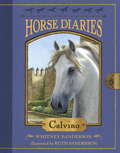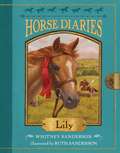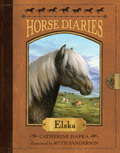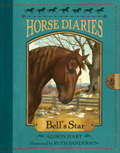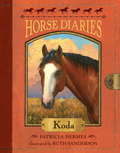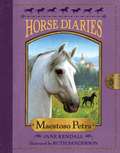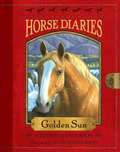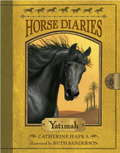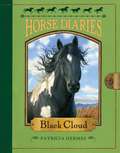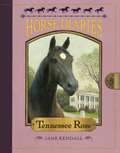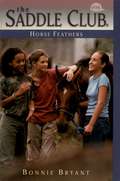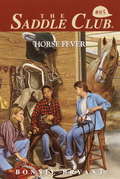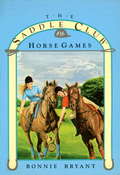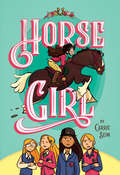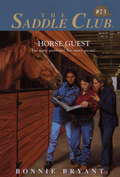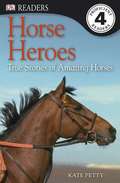- Table View
- List View
Horse Diaries #14: Calvino
by Ruth Sanderson Whitney SandersonFor all lovers of horses and history! This latest book in the Horse Diaries series features an Andalusian horse in romantic sixteenth-century Spain. Southern Spain, 1570s Calvino is a dapple-gray Andalusian stallion. He grew up driving cattle in the mountains, but soon he catches the eye of King Philip II’s horse master. Now Calvino and his young rider, Rico, must learn the complicated moves of doma clásica riding. Calvino doesn’t understand the use of this prancing—until he and Rico are chosen to represent the king in a deadly bullfight that will put all his skills to the test. Here is Calvino’s story . . . in his own words. Praise for Elska (Horse Diaries #1): “A must for horse lovers, the cozy and exciting adventure will draw a wide audience.” —Booklist
Horse Diaries #15: Lily
by Ruth Sanderson Whitney SandersonFor all lovers of horses and history! In the latest book in the Horse Diaries series, meet Lily, a strawberry roan Welsh pony with a competitive heart!SOUTH WALES, 1939: Lily, a strawberry roan Welsh pony, loves Pony Club! She and her rider, Gwen, compete in and win lots of events, including Lily's favorite--jumping! Then Bridget joins the Pony Club. The English girl was sent from London to escape the bombings brought on by war. Gwen tries to be friends, but Bridget is sour and mean. Even worse, Bridget and her horse, Bron, make the perfect jump look easy. Now Gwen and Lily have some real competition. . . .
Horse Diaries #16: Penny (Horse Diaries #16)
by Whitney SandersonFor all lovers of horses and history! In the latest book in the Horse Diaries series, meet Penny, a blue-eyed palomino paint mare who grows up in the Wild West of California during the Gold Rush!CALIFORNIA, 1850. Penny is a blue-eyed palomino paint mare with a taste for adventure! She and a boy named Jesse search for gold in the hills of Northern California. After striking it rich and then losing everything, Jesse and Penny join the Pony Express. The job is a tough one, but Penny loves a challenge! Here is Penny's story . . . in her own words.Love horses and history? Don't miss the stories of Elska, Bell's Star, Calvino, Lily, and more in the Horse Diaries series!
Horse Diaries #1: Elska (Horse Diaries #1)
by Catherine Hapka Ruth SandersonIceland, circa AD 1000Elska is a silver dapple Icelandic filly. She spends summers frisking about the countryside and winters in the farmyard, where the girl human Amma takes special care of her. But when a powerful neighbor notices Elska, her contented life suddenly changes. Here is Elska's story . . . in her own words.From the Hardcover edition.
Horse Diaries #2: Bell's Star
by Alison Hart Ruth SandersonVermont, 1850sBell's Star is a brown Morgan colt with a white star and two white stockings. He was bred for hard work, yet he longs to run free with his human friend, Katie, on his back. But when Star helps rescue a runaway slave girl, his ideas about freedom may change forever. Here is Star's story . . . in his own words. With exciting and knowledgeable text and lovely black-and-white art throughout--both by real horse owners--Horse Diaries are the perfect fit for all lovers of horses and history!From the Hardcover edition.
Horse Diaries #3: Koda
by Patricia Hermes Ruth SandersonFor anyone who has ever dreamed of hearing a horse's story . . .Independence, Missouri, 1846Koda is a bay quarter horse with a white blaze. He loves to explore the countryside and run free with his human friend Jasmine nearby. But after Koda sets out with Jasmine's family on a long and dusty wagon train journey on the Oregon Trail, he finds out what is truly important to him. Here is Koda's story . . . in his own words.With moving and knowledgeable text and lovely black-and-white art throughout--both by real horse people--this is the perfect fit for all lovers of horses and history!From the Trade Paperback edition.
Horse Diaries #4: Maestoso Petra (Horse Diaries #4)
by Ruth Sanderson Jane KendallVienna, Austria, 1938Maestoso Petra is a world-famous Lipizzaner stallion. He has spent years in the Spanish Riding School, training to perform the complex airs above the ground that only Lipizzaner can accomplish. But when World War II breaks out in Europe, he learns to think less about performing and more about survival. Here is Maestoso Petra's story . . . in his own words.From the Trade Paperback edition.
Horse Diaries #5: Golden Sun
by Ruth Sanderson Whitney SandersonFor anyone who has ever dreamed of hearing a horse's story...Oregon, 1790Golden Sun is a chestnut snowflake Appaloosa. In summer, he treks through the mountains with his rider, a Nez Perce boy named Little Turtle, as he gathers healing plants. But when Little Turtle's best friend falls ill, Golden Sun discovers his true calling. Here is Golden Sun's story...in his own words.With moving and knowledgeable text and lovely black and white art throughout--by a mother-daughter team of horse experts--this is the perfect fit for all lovers of horses and history!From the Trade Paperback edition.
Horse Diaries #6: Yatimah
by Catherine Hapka Ruth SandersonFor all lovers of horses and history, it's the next book in the popular Horse Diaries series. Born in the Arabian Desert in the ninth century, Yatimah is a black Arabian filly whose name means "orphan." She enjoys her life at the oasis, with sheep to tease, other foals to race, and the daughter of her Bedouin owner to take care of her. But when the colt who is her foster brother is stolen in a raid, Yatimah realizes her true birthright. Like Black Beauty, this moving novel is told in first person from the horse's own point of view and includes an appendix full of photos and facts about Arabian horses and Bedouin culture.From the Trade Paperback edition.
Horse Diaries #6: Yatimah
by Catherine Hapka Ruth SandersonFor all lovers of horses and history, it's the next book in the popular Horse Diaries series. Born in the Arabian Desert in the ninth century, Yatimah is a black Arabian filly whose name means "orphan." She enjoys her life at the oasis, with sheep to tease, other foals to race, and the daughter of her Bedouin owner to take care of her. But when the colt who is her foster brother is stolen in a raid, Yatimah realizes her true birthright. Like Black Beauty, this moving novel is told in first person from the horse's own point of view and includes an appendix full of photos and facts about Arabian horses and Bedouin culture.From the Trade Paperback edition.
Horse Diaries #7: Risky Chance (Horse Diaries #7)
by Alison Hart Ruth SandersonFor all lovers of horses and history, it's the next book in the popular Horse Diaries series. Born in California at the start of the Great Depression, Risky Chance is a gray thoroughbred who was born to race. Life at the track and being spoiled by his jockey's young daughter, Marie, is all Chance could ask for. He loves nothing more than running fast and winning. But after an accident, Chance discovers a side of horse racing that has little to do with glory.Like Black Beauty, this moving novel is told in first person from the horse's own point of view and includes an appendix full of photos and facts about thoroughbreds, horse racing, and the Great Depression.From the Trade Paperback edition.
Horse Diaries #8: Black Cloud (Horse Diaries #8)
by Patricia Hermes Astrid SheckelsBorn in Northern Nevada in 1950, Black Cloud is a black-and-white mustang colt. He loves roaming free with the rest of his herd, playing with the other foals, and learning the ways of wild horses. But when humans intrude on this wandering life, Black Cloud's worled is changed forever. Like Black Beauty, this moving novel is told in first person from the horse's own point of view and includes an appendix full of photos and facts about mustangs and the history of the laws protecting them.From the Trade Paperback edition.
Horse Diaries #9: Tennessee Rose (Horse Diaries #9)
by Jane Kendall Astrid SheckelsAlabama, 1856. Tennessee Rose is a dark bay Tennessee Walking Horse with a rose-shaped marking on her forehead. She loves dashing around the plantation in the running walk that her breed is famous for, then coming back to her comfortable stall and her friend Levi, the slave boy who is her groom. But as the Civil War approaches, Rosie begins to question plantation life. Is slavery fair? Could Levi be free? Like Black Beauty, this moving novel is told in first person from the horse's point of view and includes an appendix full of photos and facts about Tennessee Walking Horses and the Civil War.
Horse Diaries: Golden Sun
by Whitney SandersonFor anyone who has ever dreamed of hearing a horse’s story. . . Oregon, 1790 Golden Sun is a chestnut snowflake Appaloosa. In summer, he treks through the mountains with his rider, a Nez Perce boy named Little Turtle, as he gathers healing plants. But when Little Turtle’s best friend falls ill, Golden Sun discovers his true calling. Here is Golden Sun’s story. . . in his own words. With moving and knowledgeable text and lovely black and white art throughout-by a mother-daughter team of horse experts-this is the perfect fit for all lovers of horses and history! From the Trade Paperback edition.
Horse Diaries: Koda
by Patricia HermesFor anyone who has ever dreamed of hearing a horse’s story . . . Independence, Missouri, 1846 Koda is a bay quarter horse with a white blaze. He loves to explore the countryside and run free with his human friend Jasmine nearby. But after Koda sets out with Jasmine’s family on a long and dusty wagon train journey on the Oregon Trail, he finds out what is truly important to him. Here is Koda’s story . . . in his own words. With moving and knowledgeable text and lovely black-and-white art throughout—both by real horse people—this is the perfect fit for all lovers of horses and history! From the Trade Paperback edition.
Horse Feathers (Saddle Club #98)
by Bonnie BryantStevie Lake's a mom-to eight fuzzy goslings!Stevie Lake entered a contest to win a down comforter. Instead she got a new "family"-a nestful of goose eggs. But when the eggs hatch, it's love at first sight for Stevie and the goslings. Now Stevie's learning that being a mom is hard work: the goslings want to go everywhere Stevie goes, even to Pine Hollow. Stevie has to keep her "kids" safe while trying to learn a new skill-vaulting. The Saddle Club is determined to master vaulting and show Veronica diAngelo that success takes more than fancy coaches. Can they pull this off? Or is The Saddle Club plus eight goslings and one vaulting horse a recipe for disaster?
Horse Fever (Girl Talk #25)
by L. E. BlairWhat do you do when the most beautiful horse in the world scares you to death? When Randy and her friends decide to take riding lessons, Randy's determined not to let a secret from her riding days in New York City ruin her fun. But can Randy manage to overcome her past for the love of a horse?
Horse Fever (Saddle Club #85)
by Bonnie BryantJanuary is the cruelest month, at least for the Saddle Club. The weather is miserable: cold, rainy, and muddy. No one can go riding outside, and everyone is sick and tired of being inside. The only things left to do are clean tack and ride in the indoor ring. The Saddle Club is bored--bored of riding and even of horses. So what can they do? Lisa decides to try her hand at needlepoint--can't get much further away from riding than that. Carole decides that this would be the perfect opportunity to write a great novel. And Stevie decides that a little time in the kitchen whipping up treats sounds like a great idea. Will these activities help them rediscover their love of horses? Or is the Saddle Club about to untack for good?
Horse Games (Saddle Club #16)
by Bonnie BryantStevie is excited about a great new sport--polocrosse. When she learns that the Horse Wise Pony Club will be playing against her boyfriend's team, she's thrilled. Now she'll finally have the chance to show him what a good rider she is!
Horse Girl
by Carrie SeimMean Girls meets Black Beauty in Horse Girl by celebrated author Carrie Seim--a funny and tender middle-grade novel about finding your forever herd."This book is funny and exciting. Beautifully portrays both the pleasures and risks of riding horses and also of being a teen. Very original, and a great pleasure to read."--Jane Smiley, Pulitzer Prize-winning author Wills is a seventh grader who's head-over-hoof for horses, and beyond excited when she gets the chance to start training at the prestigious Oakwood Riding Academy. But Amara--the Queen of the #HorseGirls--and her posse aren't going to let the certifiably dork-tagious Wills trot her way into their club so easily. Between learning the reins of horse riding, dealing with her Air Force pilot mom being stationed thousands of miles from home, and keeping it together in front of (gasp!) Horse Boys, Wills learns that becoming a part of the #HorseGirl world isn't easy. But with her rescue horse, Clyde, at her side, it sure will be fun.Complete with comedic, original hoof notes to acquaint the less equestrian among us, Horse Girl delivers everything a young readers wants: mean girls, boy problems, and embarrassingly goofy dad jokes. And it does so on the back of a pony.
Horse Guest (Saddle Club #73)
by Bonnie BryantPine Hollow is boarding some horses from a neighboring stable. One of the horses has special problems that require help from The Saddle Club. But first they have to figure out how to get the horse to tell them what's wrong.Meanwhile, Stevie's grandmother is visiting the Lakes, and everyone has resolved to be on their best behavior. Can Stevie and her brothers keep their resolution? And what happens when they learn that Granny likes the normal family chaos?
Horse Happy (Wind Dancers, Book #2)
by Sibley MillerMeet the Wind Dancers Four tiny horses with shiny manes and shimmering wings burst from a puff of dandelion seeds! Four magical horses who can fly. BOOK 2: Horse Happy The Wind Dancers happily set up home in a lovely apple tree house. They're ready to celebrate by going blackberry picking! Picture descriptions added.
Horse Hero (Fountas & Pinnell LLI Red #Level M)
by Terry ShannonWhen Australian farmer Anthony Sexton was surrounded by wildfire, his horse saved his life.
Horse Heroes: True Stories of Amazing Horses
by Kate PettyTrigger is a special horse -- he can write his name! His is just one of the real-life stories in Horse Heroes. These 48-page books about fascinating subjects like pirates, mummies, and volcanoes are for proficient readers who can understand a rich vocabulary and challenging sentence structure. In addition to the stunning photographs, informative sidebars, and glossary, readers will find archival photographs and paintings.
